Developing a Strategic Marketing Plan for Milco: A Case Study
VerifiedAdded on 2023/06/12
|36
|7787
|157
Report
AI Summary
This report provides a detailed analysis of Milco's strategic marketing plan, focusing on how effective marketing strategies can positively impact business performance. It includes an external environmental analysis using PESTEL, and a medium-term marketing plan with defined market goals and target markets. The report evaluates Milco's customer profile, segmentation plan (geographic, demographic, and psychographic), and emphasizes diversity in services. It also covers internal analysis using Porter's five forces to identify competitors, marketing mix strategies, stakeholder analysis, and an Ansoff Matrix for product development. The report includes a risk matrix analysis and recommendations for overcoming potential risks. The study further explores macro and micro-environmental factors, BCG Matrix, Reger’s Innovation and provides a financial forecast and promotional budget to support the marketing plan.
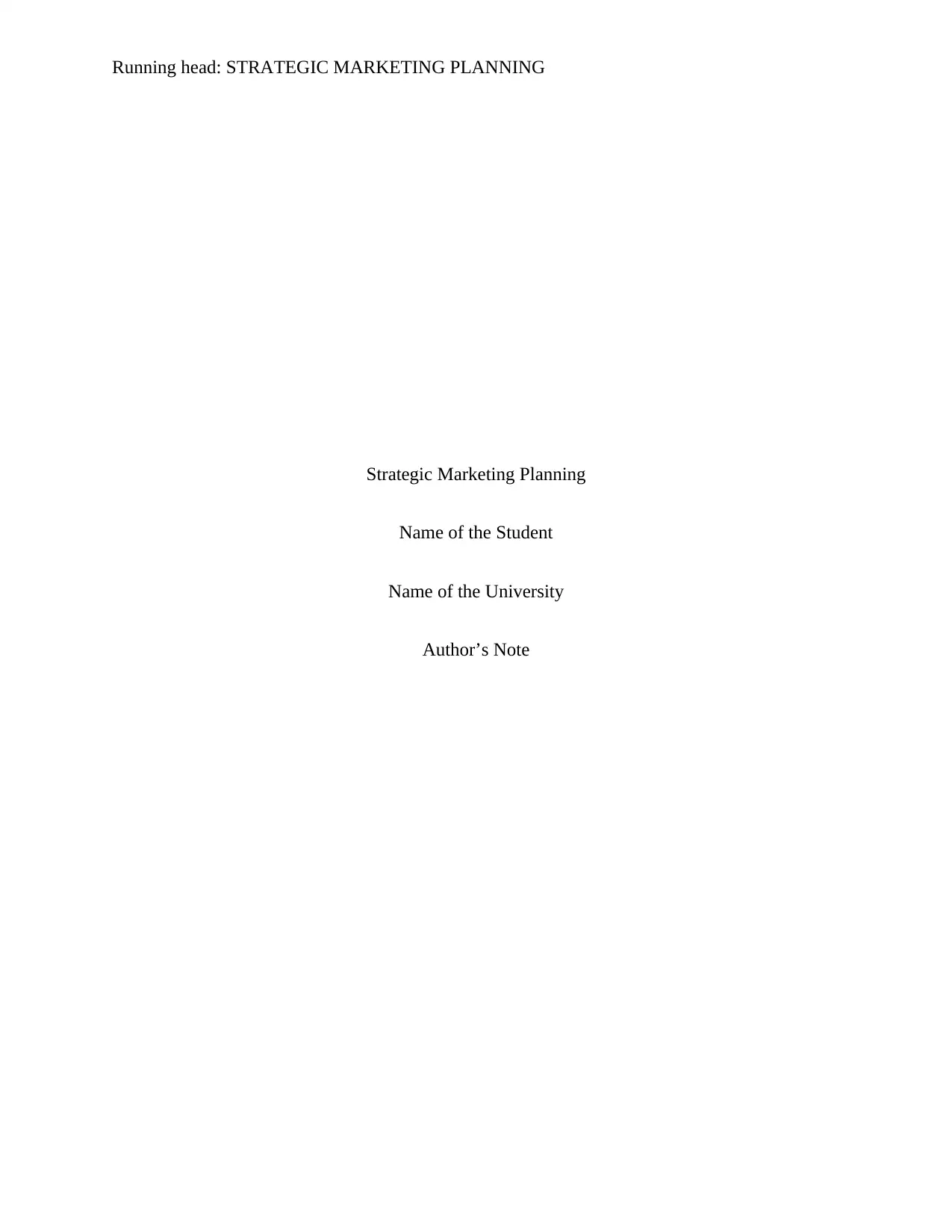
Running head: STRATEGIC MARKETING PLANNING
Strategic Marketing Planning
Name of the Student
Name of the University
Author’s Note
Strategic Marketing Planning
Name of the Student
Name of the University
Author’s Note
Paraphrase This Document
Need a fresh take? Get an instant paraphrase of this document with our AI Paraphraser
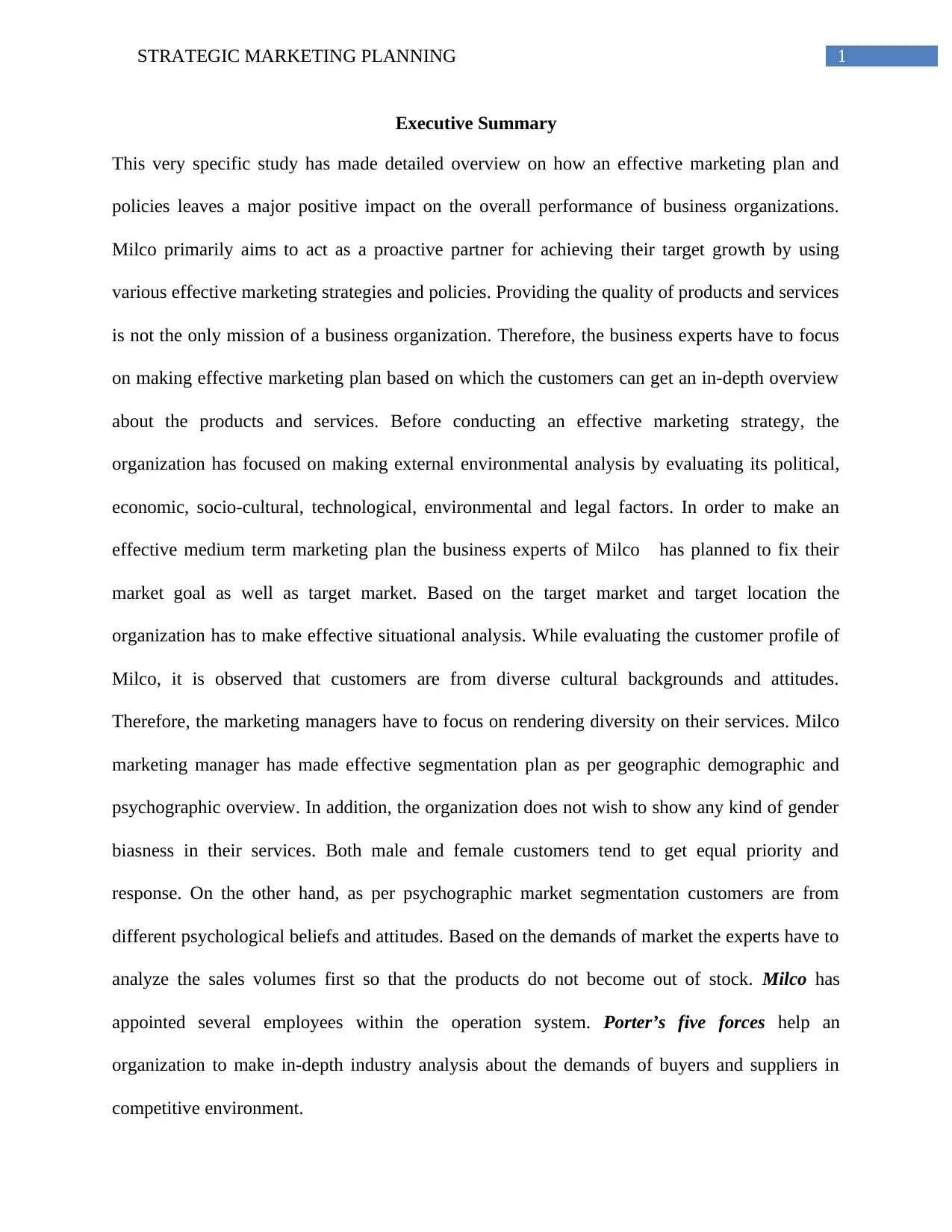
1STRATEGIC MARKETING PLANNING
Executive Summary
This very specific study has made detailed overview on how an effective marketing plan and
policies leaves a major positive impact on the overall performance of business organizations.
Milco primarily aims to act as a proactive partner for achieving their target growth by using
various effective marketing strategies and policies. Providing the quality of products and services
is not the only mission of a business organization. Therefore, the business experts have to focus
on making effective marketing plan based on which the customers can get an in-depth overview
about the products and services. Before conducting an effective marketing strategy, the
organization has focused on making external environmental analysis by evaluating its political,
economic, socio-cultural, technological, environmental and legal factors. In order to make an
effective medium term marketing plan the business experts of Milco has planned to fix their
market goal as well as target market. Based on the target market and target location the
organization has to make effective situational analysis. While evaluating the customer profile of
Milco, it is observed that customers are from diverse cultural backgrounds and attitudes.
Therefore, the marketing managers have to focus on rendering diversity on their services. Milco
marketing manager has made effective segmentation plan as per geographic demographic and
psychographic overview. In addition, the organization does not wish to show any kind of gender
biasness in their services. Both male and female customers tend to get equal priority and
response. On the other hand, as per psychographic market segmentation customers are from
different psychological beliefs and attitudes. Based on the demands of market the experts have to
analyze the sales volumes first so that the products do not become out of stock. Milco has
appointed several employees within the operation system. Porter’s five forces help an
organization to make in-depth industry analysis about the demands of buyers and suppliers in
competitive environment.
Executive Summary
This very specific study has made detailed overview on how an effective marketing plan and
policies leaves a major positive impact on the overall performance of business organizations.
Milco primarily aims to act as a proactive partner for achieving their target growth by using
various effective marketing strategies and policies. Providing the quality of products and services
is not the only mission of a business organization. Therefore, the business experts have to focus
on making effective marketing plan based on which the customers can get an in-depth overview
about the products and services. Before conducting an effective marketing strategy, the
organization has focused on making external environmental analysis by evaluating its political,
economic, socio-cultural, technological, environmental and legal factors. In order to make an
effective medium term marketing plan the business experts of Milco has planned to fix their
market goal as well as target market. Based on the target market and target location the
organization has to make effective situational analysis. While evaluating the customer profile of
Milco, it is observed that customers are from diverse cultural backgrounds and attitudes.
Therefore, the marketing managers have to focus on rendering diversity on their services. Milco
marketing manager has made effective segmentation plan as per geographic demographic and
psychographic overview. In addition, the organization does not wish to show any kind of gender
biasness in their services. Both male and female customers tend to get equal priority and
response. On the other hand, as per psychographic market segmentation customers are from
different psychological beliefs and attitudes. Based on the demands of market the experts have to
analyze the sales volumes first so that the products do not become out of stock. Milco has
appointed several employees within the operation system. Porter’s five forces help an
organization to make in-depth industry analysis about the demands of buyers and suppliers in
competitive environment.
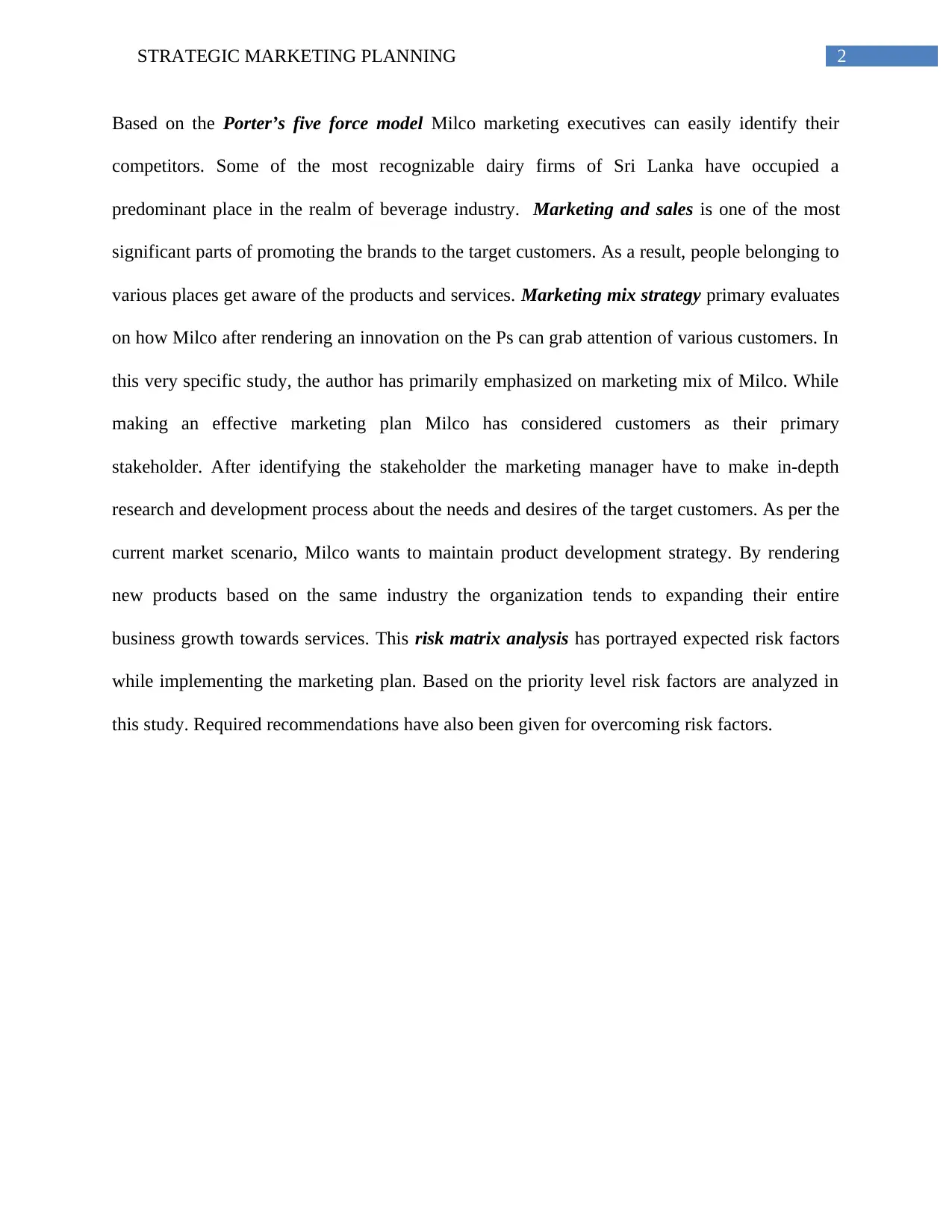
2STRATEGIC MARKETING PLANNING
Based on the Porter’s five force model Milco marketing executives can easily identify their
competitors. Some of the most recognizable dairy firms of Sri Lanka have occupied a
predominant place in the realm of beverage industry. Marketing and sales is one of the most
significant parts of promoting the brands to the target customers. As a result, people belonging to
various places get aware of the products and services. Marketing mix strategy primary evaluates
on how Milco after rendering an innovation on the Ps can grab attention of various customers. In
this very specific study, the author has primarily emphasized on marketing mix of Milco. While
making an effective marketing plan Milco has considered customers as their primary
stakeholder. After identifying the stakeholder the marketing manager have to make in-depth
research and development process about the needs and desires of the target customers. As per the
current market scenario, Milco wants to maintain product development strategy. By rendering
new products based on the same industry the organization tends to expanding their entire
business growth towards services. This risk matrix analysis has portrayed expected risk factors
while implementing the marketing plan. Based on the priority level risk factors are analyzed in
this study. Required recommendations have also been given for overcoming risk factors.
Based on the Porter’s five force model Milco marketing executives can easily identify their
competitors. Some of the most recognizable dairy firms of Sri Lanka have occupied a
predominant place in the realm of beverage industry. Marketing and sales is one of the most
significant parts of promoting the brands to the target customers. As a result, people belonging to
various places get aware of the products and services. Marketing mix strategy primary evaluates
on how Milco after rendering an innovation on the Ps can grab attention of various customers. In
this very specific study, the author has primarily emphasized on marketing mix of Milco. While
making an effective marketing plan Milco has considered customers as their primary
stakeholder. After identifying the stakeholder the marketing manager have to make in-depth
research and development process about the needs and desires of the target customers. As per the
current market scenario, Milco wants to maintain product development strategy. By rendering
new products based on the same industry the organization tends to expanding their entire
business growth towards services. This risk matrix analysis has portrayed expected risk factors
while implementing the marketing plan. Based on the priority level risk factors are analyzed in
this study. Required recommendations have also been given for overcoming risk factors.
⊘ This is a preview!⊘
Do you want full access?
Subscribe today to unlock all pages.

Trusted by 1+ million students worldwide

3STRATEGIC MARKETING PLANNING
Table of Contents
1. Introduction..................................................................................................................................5
2. Corporate strategy:.......................................................................................................................5
2.1 Mission and vision of the company:..........................................................................................5
2.2 Summary of the overall position:..............................................................................................6
2.3 Scenario planning:.....................................................................................................................7
3. Internal analysis:..........................................................................................................................8
3.1 Porter’s five forces:....................................................................................................................8
3.2 Competitor’s analysis:...............................................................................................................9
3.3 SWOT:.....................................................................................................................................10
4. Marketing Objectives and financial objectives:........................................................................12
5.1 Customer profile:.....................................................................................................................12
5.2 Segmentation:..........................................................................................................................12
5.3 7Ps of marketing mix:..............................................................................................................14
Marketing mix:..............................................................................................................................14
6. Implementation:.........................................................................................................................16
6.1 Competency evaluation:..........................................................................................................16
6.2 Stakeholder analysis:...............................................................................................................17
6.3 Ansoff Matrix:.........................................................................................................................17
7.1 Financial Forecast (Profit and loss analysis)...........................................................................18
7.2 Effective promotional budget:.................................................................................................19
Risk matrix:...................................................................................................................................21
Table of Contents
1. Introduction..................................................................................................................................5
2. Corporate strategy:.......................................................................................................................5
2.1 Mission and vision of the company:..........................................................................................5
2.2 Summary of the overall position:..............................................................................................6
2.3 Scenario planning:.....................................................................................................................7
3. Internal analysis:..........................................................................................................................8
3.1 Porter’s five forces:....................................................................................................................8
3.2 Competitor’s analysis:...............................................................................................................9
3.3 SWOT:.....................................................................................................................................10
4. Marketing Objectives and financial objectives:........................................................................12
5.1 Customer profile:.....................................................................................................................12
5.2 Segmentation:..........................................................................................................................12
5.3 7Ps of marketing mix:..............................................................................................................14
Marketing mix:..............................................................................................................................14
6. Implementation:.........................................................................................................................16
6.1 Competency evaluation:..........................................................................................................16
6.2 Stakeholder analysis:...............................................................................................................17
6.3 Ansoff Matrix:.........................................................................................................................17
7.1 Financial Forecast (Profit and loss analysis)...........................................................................18
7.2 Effective promotional budget:.................................................................................................19
Risk matrix:...................................................................................................................................21
Paraphrase This Document
Need a fresh take? Get an instant paraphrase of this document with our AI Paraphraser
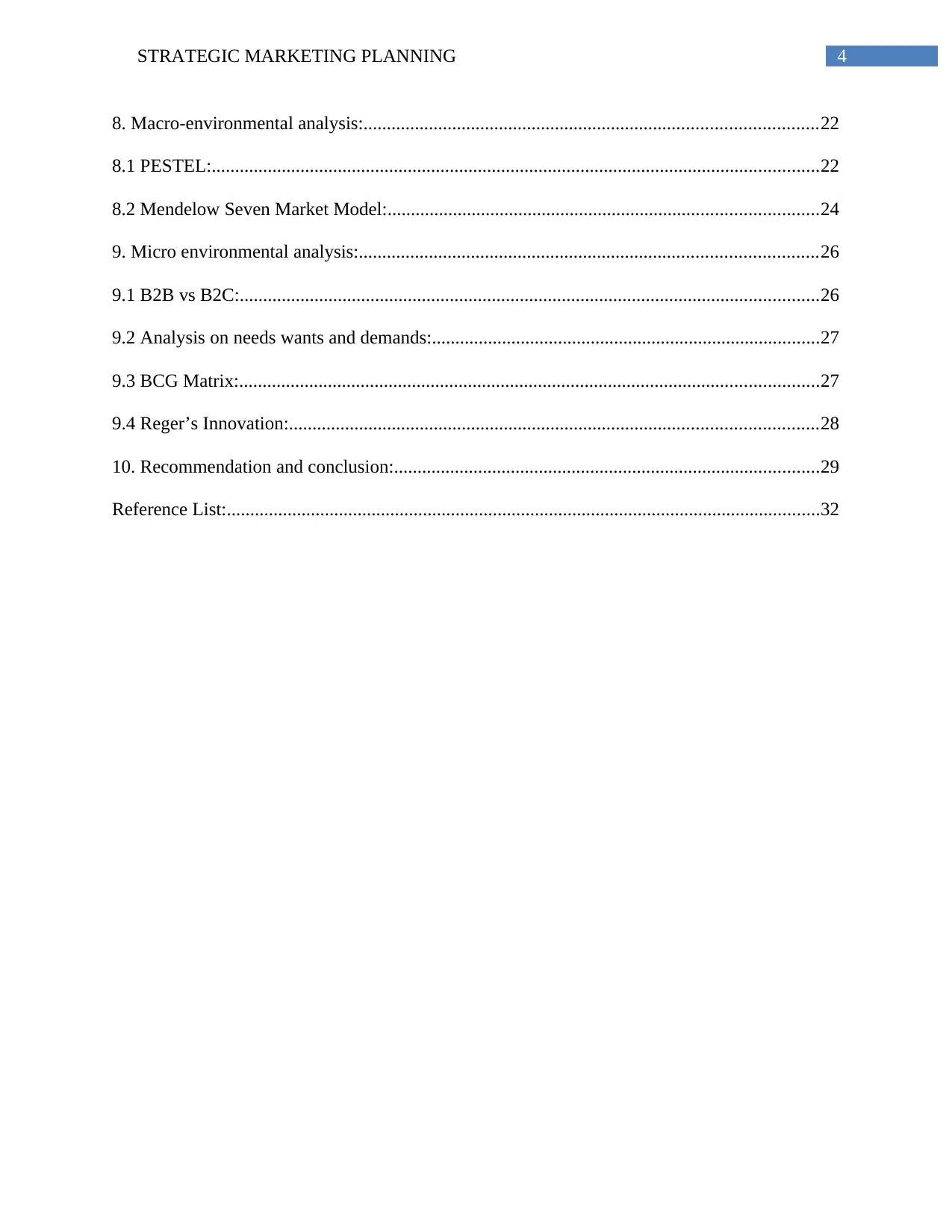
4STRATEGIC MARKETING PLANNING
8. Macro-environmental analysis:.................................................................................................22
8.1 PESTEL:..................................................................................................................................22
8.2 Mendelow Seven Market Model:............................................................................................24
9. Micro environmental analysis:..................................................................................................26
9.1 B2B vs B2C:............................................................................................................................26
9.2 Analysis on needs wants and demands:...................................................................................27
9.3 BCG Matrix:............................................................................................................................27
9.4 Reger’s Innovation:.................................................................................................................28
10. Recommendation and conclusion:...........................................................................................29
Reference List:...............................................................................................................................32
8. Macro-environmental analysis:.................................................................................................22
8.1 PESTEL:..................................................................................................................................22
8.2 Mendelow Seven Market Model:............................................................................................24
9. Micro environmental analysis:..................................................................................................26
9.1 B2B vs B2C:............................................................................................................................26
9.2 Analysis on needs wants and demands:...................................................................................27
9.3 BCG Matrix:............................................................................................................................27
9.4 Reger’s Innovation:.................................................................................................................28
10. Recommendation and conclusion:...........................................................................................29
Reference List:...............................................................................................................................32
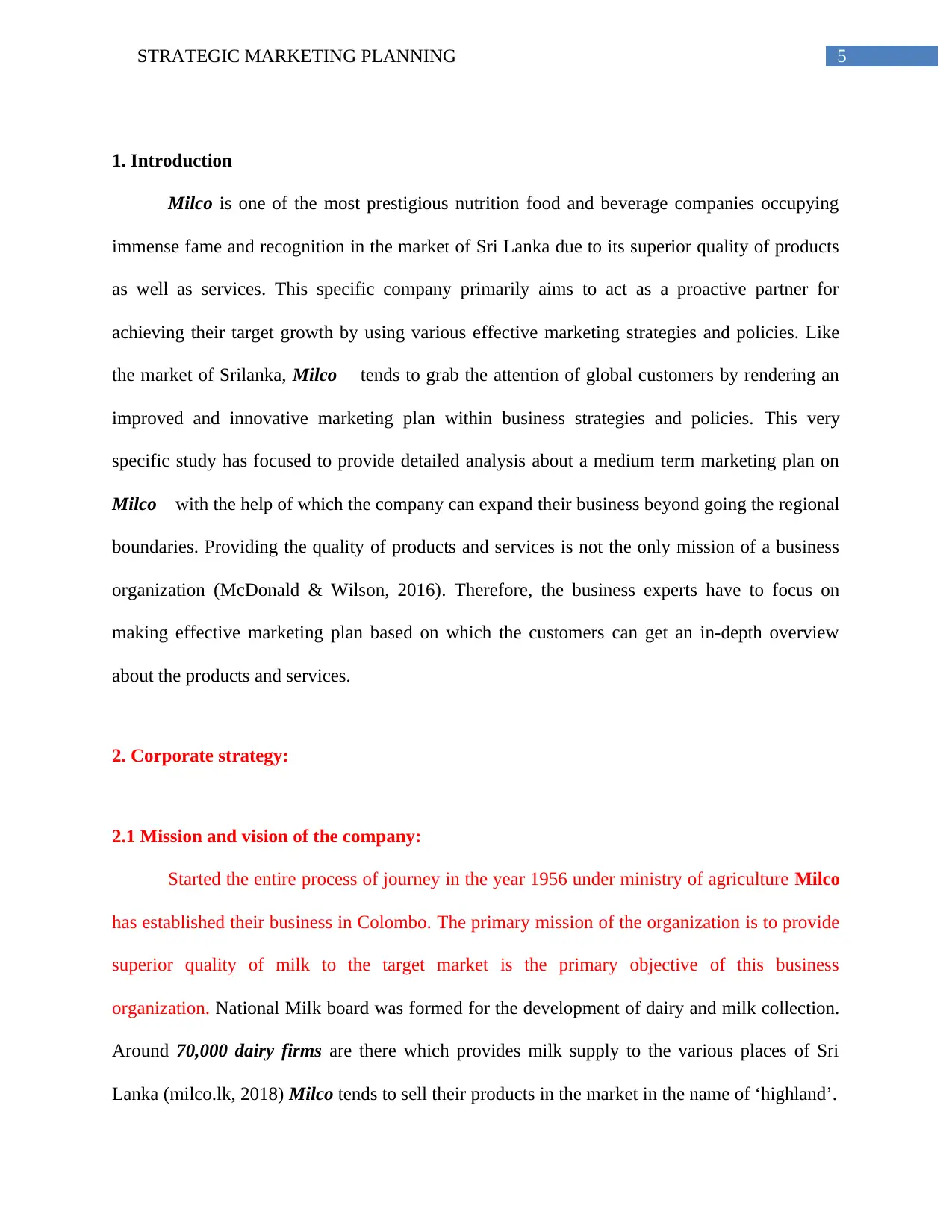
5STRATEGIC MARKETING PLANNING
1. Introduction
Milco is one of the most prestigious nutrition food and beverage companies occupying
immense fame and recognition in the market of Sri Lanka due to its superior quality of products
as well as services. This specific company primarily aims to act as a proactive partner for
achieving their target growth by using various effective marketing strategies and policies. Like
the market of Srilanka, Milco tends to grab the attention of global customers by rendering an
improved and innovative marketing plan within business strategies and policies. This very
specific study has focused to provide detailed analysis about a medium term marketing plan on
Milco with the help of which the company can expand their business beyond going the regional
boundaries. Providing the quality of products and services is not the only mission of a business
organization (McDonald & Wilson, 2016). Therefore, the business experts have to focus on
making effective marketing plan based on which the customers can get an in-depth overview
about the products and services.
2. Corporate strategy:
2.1 Mission and vision of the company:
Started the entire process of journey in the year 1956 under ministry of agriculture Milco
has established their business in Colombo. The primary mission of the organization is to provide
superior quality of milk to the target market is the primary objective of this business
organization. National Milk board was formed for the development of dairy and milk collection.
Around 70,000 dairy firms are there which provides milk supply to the various places of Sri
Lanka (milco.lk, 2018) Milco tends to sell their products in the market in the name of ‘highland’.
1. Introduction
Milco is one of the most prestigious nutrition food and beverage companies occupying
immense fame and recognition in the market of Sri Lanka due to its superior quality of products
as well as services. This specific company primarily aims to act as a proactive partner for
achieving their target growth by using various effective marketing strategies and policies. Like
the market of Srilanka, Milco tends to grab the attention of global customers by rendering an
improved and innovative marketing plan within business strategies and policies. This very
specific study has focused to provide detailed analysis about a medium term marketing plan on
Milco with the help of which the company can expand their business beyond going the regional
boundaries. Providing the quality of products and services is not the only mission of a business
organization (McDonald & Wilson, 2016). Therefore, the business experts have to focus on
making effective marketing plan based on which the customers can get an in-depth overview
about the products and services.
2. Corporate strategy:
2.1 Mission and vision of the company:
Started the entire process of journey in the year 1956 under ministry of agriculture Milco
has established their business in Colombo. The primary mission of the organization is to provide
superior quality of milk to the target market is the primary objective of this business
organization. National Milk board was formed for the development of dairy and milk collection.
Around 70,000 dairy firms are there which provides milk supply to the various places of Sri
Lanka (milco.lk, 2018) Milco tends to sell their products in the market in the name of ‘highland’.
⊘ This is a preview!⊘
Do you want full access?
Subscribe today to unlock all pages.

Trusted by 1+ million students worldwide
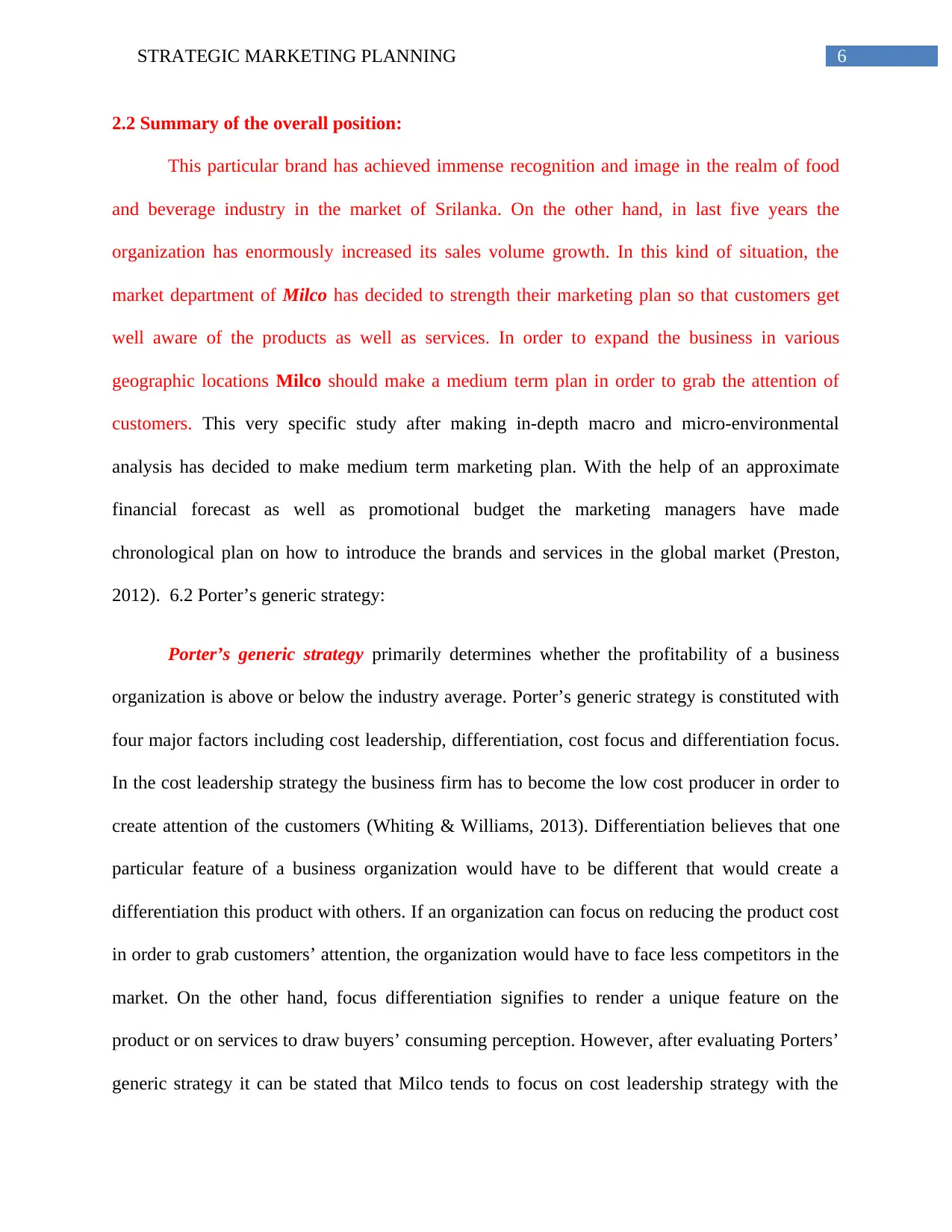
6STRATEGIC MARKETING PLANNING
2.2 Summary of the overall position:
This particular brand has achieved immense recognition and image in the realm of food
and beverage industry in the market of Srilanka. On the other hand, in last five years the
organization has enormously increased its sales volume growth. In this kind of situation, the
market department of Milco has decided to strength their marketing plan so that customers get
well aware of the products as well as services. In order to expand the business in various
geographic locations Milco should make a medium term plan in order to grab the attention of
customers. This very specific study after making in-depth macro and micro-environmental
analysis has decided to make medium term marketing plan. With the help of an approximate
financial forecast as well as promotional budget the marketing managers have made
chronological plan on how to introduce the brands and services in the global market (Preston,
2012). 6.2 Porter’s generic strategy:
Porter’s generic strategy primarily determines whether the profitability of a business
organization is above or below the industry average. Porter’s generic strategy is constituted with
four major factors including cost leadership, differentiation, cost focus and differentiation focus.
In the cost leadership strategy the business firm has to become the low cost producer in order to
create attention of the customers (Whiting & Williams, 2013). Differentiation believes that one
particular feature of a business organization would have to be different that would create a
differentiation this product with others. If an organization can focus on reducing the product cost
in order to grab customers’ attention, the organization would have to face less competitors in the
market. On the other hand, focus differentiation signifies to render a unique feature on the
product or on services to draw buyers’ consuming perception. However, after evaluating Porters’
generic strategy it can be stated that Milco tends to focus on cost leadership strategy with the
2.2 Summary of the overall position:
This particular brand has achieved immense recognition and image in the realm of food
and beverage industry in the market of Srilanka. On the other hand, in last five years the
organization has enormously increased its sales volume growth. In this kind of situation, the
market department of Milco has decided to strength their marketing plan so that customers get
well aware of the products as well as services. In order to expand the business in various
geographic locations Milco should make a medium term plan in order to grab the attention of
customers. This very specific study after making in-depth macro and micro-environmental
analysis has decided to make medium term marketing plan. With the help of an approximate
financial forecast as well as promotional budget the marketing managers have made
chronological plan on how to introduce the brands and services in the global market (Preston,
2012). 6.2 Porter’s generic strategy:
Porter’s generic strategy primarily determines whether the profitability of a business
organization is above or below the industry average. Porter’s generic strategy is constituted with
four major factors including cost leadership, differentiation, cost focus and differentiation focus.
In the cost leadership strategy the business firm has to become the low cost producer in order to
create attention of the customers (Whiting & Williams, 2013). Differentiation believes that one
particular feature of a business organization would have to be different that would create a
differentiation this product with others. If an organization can focus on reducing the product cost
in order to grab customers’ attention, the organization would have to face less competitors in the
market. On the other hand, focus differentiation signifies to render a unique feature on the
product or on services to draw buyers’ consuming perception. However, after evaluating Porters’
generic strategy it can be stated that Milco tends to focus on cost leadership strategy with the
Paraphrase This Document
Need a fresh take? Get an instant paraphrase of this document with our AI Paraphraser
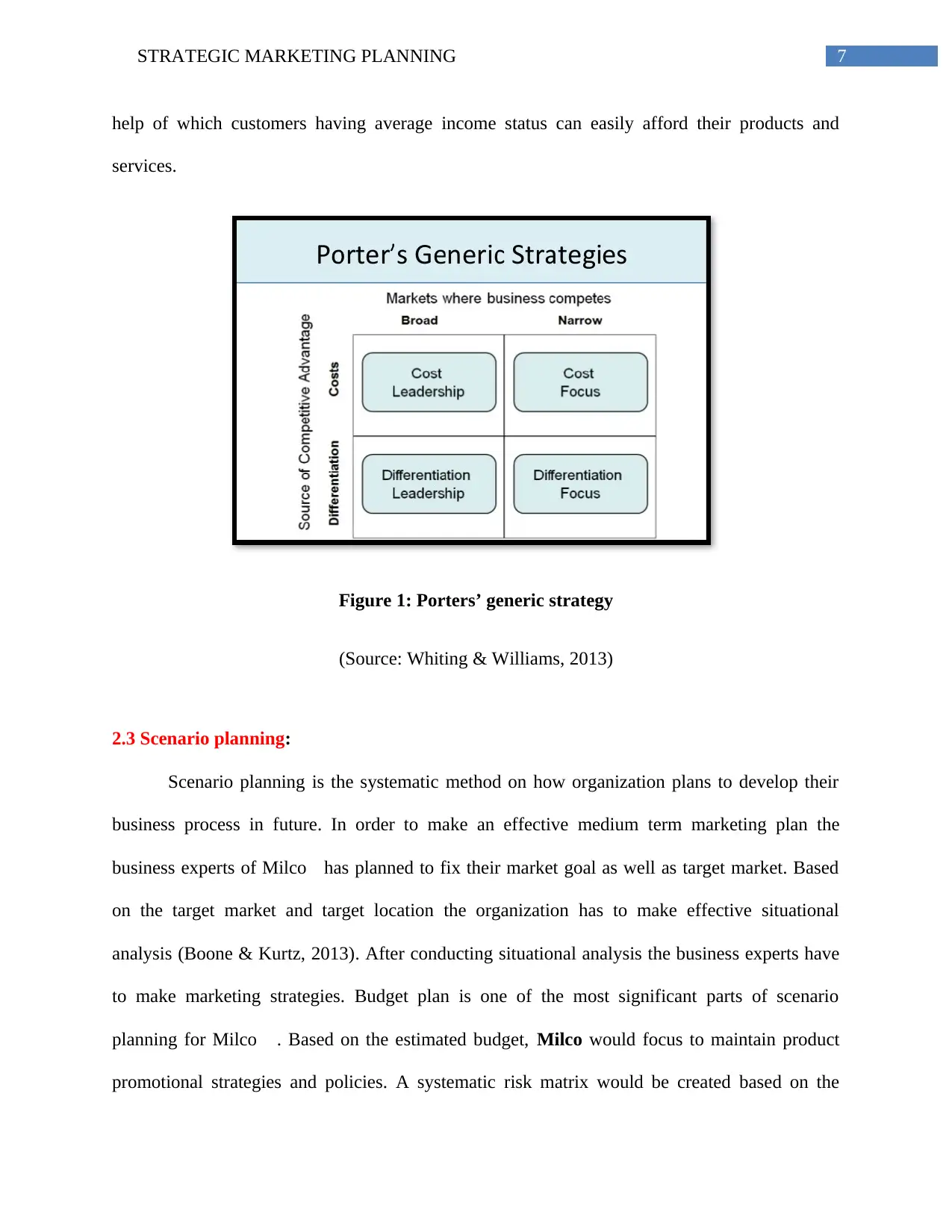
7STRATEGIC MARKETING PLANNING
help of which customers having average income status can easily afford their products and
services.
Figure 1: Porters’ generic strategy
(Source: Whiting & Williams, 2013)
2.3 Scenario planning:
Scenario planning is the systematic method on how organization plans to develop their
business process in future. In order to make an effective medium term marketing plan the
business experts of Milco has planned to fix their market goal as well as target market. Based
on the target market and target location the organization has to make effective situational
analysis (Boone & Kurtz, 2013). After conducting situational analysis the business experts have
to make marketing strategies. Budget plan is one of the most significant parts of scenario
planning for Milco . Based on the estimated budget, Milco would focus to maintain product
promotional strategies and policies. A systematic risk matrix would be created based on the
help of which customers having average income status can easily afford their products and
services.
Figure 1: Porters’ generic strategy
(Source: Whiting & Williams, 2013)
2.3 Scenario planning:
Scenario planning is the systematic method on how organization plans to develop their
business process in future. In order to make an effective medium term marketing plan the
business experts of Milco has planned to fix their market goal as well as target market. Based
on the target market and target location the organization has to make effective situational
analysis (Boone & Kurtz, 2013). After conducting situational analysis the business experts have
to make marketing strategies. Budget plan is one of the most significant parts of scenario
planning for Milco . Based on the estimated budget, Milco would focus to maintain product
promotional strategies and policies. A systematic risk matrix would be created based on the
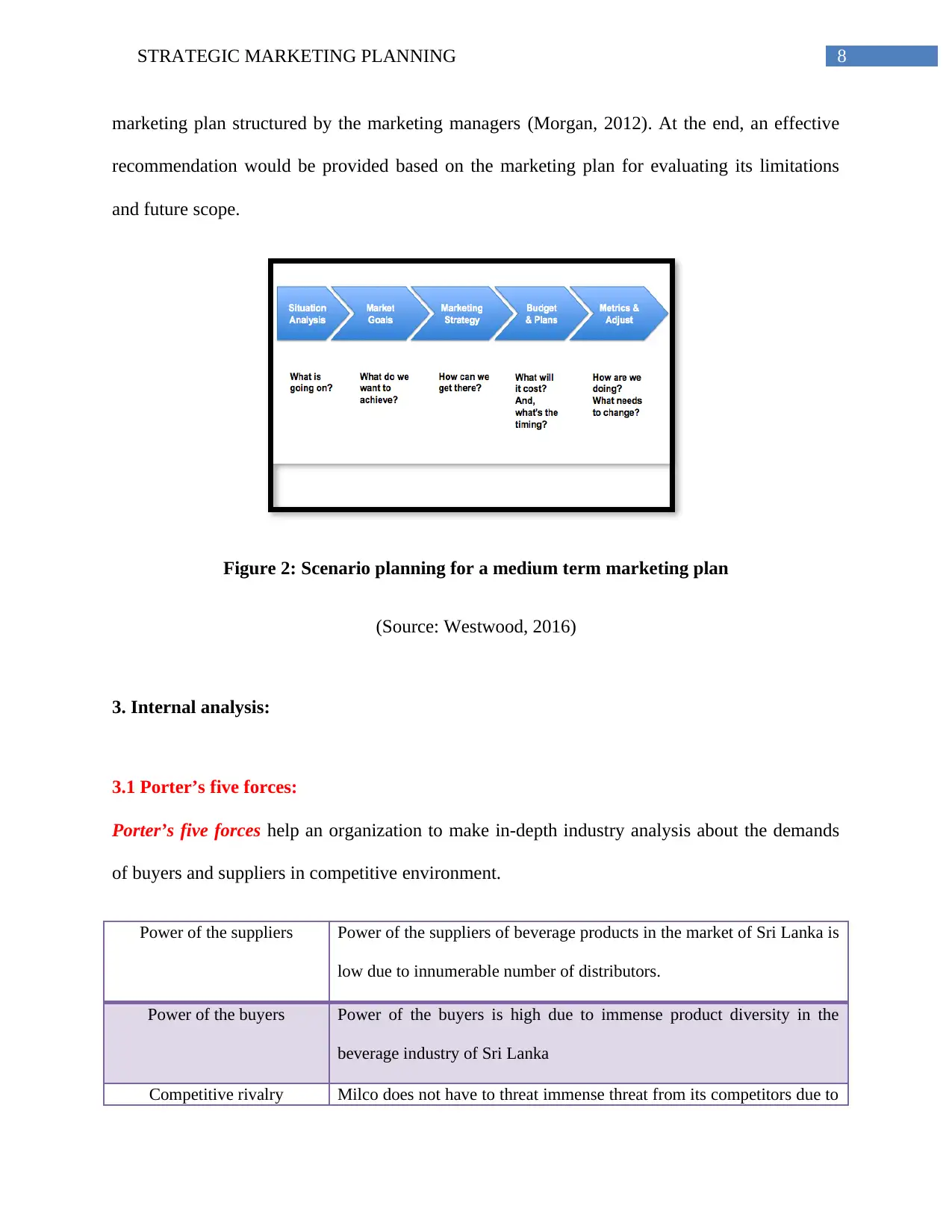
8STRATEGIC MARKETING PLANNING
marketing plan structured by the marketing managers (Morgan, 2012). At the end, an effective
recommendation would be provided based on the marketing plan for evaluating its limitations
and future scope.
Figure 2: Scenario planning for a medium term marketing plan
(Source: Westwood, 2016)
3. Internal analysis:
3.1 Porter’s five forces:
Porter’s five forces help an organization to make in-depth industry analysis about the demands
of buyers and suppliers in competitive environment.
Power of the suppliers Power of the suppliers of beverage products in the market of Sri Lanka is
low due to innumerable number of distributors.
Power of the buyers Power of the buyers is high due to immense product diversity in the
beverage industry of Sri Lanka
Competitive rivalry Milco does not have to threat immense threat from its competitors due to
marketing plan structured by the marketing managers (Morgan, 2012). At the end, an effective
recommendation would be provided based on the marketing plan for evaluating its limitations
and future scope.
Figure 2: Scenario planning for a medium term marketing plan
(Source: Westwood, 2016)
3. Internal analysis:
3.1 Porter’s five forces:
Porter’s five forces help an organization to make in-depth industry analysis about the demands
of buyers and suppliers in competitive environment.
Power of the suppliers Power of the suppliers of beverage products in the market of Sri Lanka is
low due to innumerable number of distributors.
Power of the buyers Power of the buyers is high due to immense product diversity in the
beverage industry of Sri Lanka
Competitive rivalry Milco does not have to threat immense threat from its competitors due to
⊘ This is a preview!⊘
Do you want full access?
Subscribe today to unlock all pages.

Trusted by 1+ million students worldwide

9STRATEGIC MARKETING PLANNING
monopoly of business. Milco as a milk suppler is very famous and
recognized in the market of Sri Lanka. Therefore, the organization does
not have to receive severe threats from its competitors.
Threat of the substitutes The market of Sri Lanka is constituted with large number of substitute
beverage products such as cold drinks, health drinks, fruit juice and so
on. As a result, the marketing managers have to face challenges in
drawing the attention of target customers towards their products.
Threat of new market entry Milco is prevailing in the market of Sri Lanka since 1956. Therefore, the
organization does not have to face any threat for new market entry. As a
result, both the customers and the service providers have already shared
an effective rapport with each other.
Table 1: Porter’s five force analysis on beverage industry
(Source: Kim & Ko, 2012)
3.2 Competitor’s analysis:
Competitors’ analysis is the systematic method of identifying the strengths and
weakness of its competitors before making the marketing plan. Before making an effective
competitor analysis the business executives have to focus on several factors (Lipsman et al.,
2012). The factors are as follows:
Identify the competitors:
Based on the Porter’s five force model Milco marketing executives can easily identify
their competitors. Some of the most recognizable dairy firms of Sri Lanka like Pelwatte Dairy
industries Limited, Royal dairy Lanka, Anchor Milk have occupied a predominant place in the
monopoly of business. Milco as a milk suppler is very famous and
recognized in the market of Sri Lanka. Therefore, the organization does
not have to receive severe threats from its competitors.
Threat of the substitutes The market of Sri Lanka is constituted with large number of substitute
beverage products such as cold drinks, health drinks, fruit juice and so
on. As a result, the marketing managers have to face challenges in
drawing the attention of target customers towards their products.
Threat of new market entry Milco is prevailing in the market of Sri Lanka since 1956. Therefore, the
organization does not have to face any threat for new market entry. As a
result, both the customers and the service providers have already shared
an effective rapport with each other.
Table 1: Porter’s five force analysis on beverage industry
(Source: Kim & Ko, 2012)
3.2 Competitor’s analysis:
Competitors’ analysis is the systematic method of identifying the strengths and
weakness of its competitors before making the marketing plan. Before making an effective
competitor analysis the business executives have to focus on several factors (Lipsman et al.,
2012). The factors are as follows:
Identify the competitors:
Based on the Porter’s five force model Milco marketing executives can easily identify
their competitors. Some of the most recognizable dairy firms of Sri Lanka like Pelwatte Dairy
industries Limited, Royal dairy Lanka, Anchor Milk have occupied a predominant place in the
Paraphrase This Document
Need a fresh take? Get an instant paraphrase of this document with our AI Paraphraser

10STRATEGIC MARKETING PLANNING
realm of beverage industry. Therefore, these organizations have already given major threats to
its competitors.
Analyze its strengths and weakness:
The above business brands mentioned in the study are established especially in the
market of Srilanka. As a result, these business organizations are very much restricted within the
specific geographical boundaries. As per the geographic zone these competitors are possessed
with limited number of target customers (Erdoğmuş & Cicek, 2012). However, Milco has
already established their brands in the market other countries as well. As a result, the number of
target customers is high in comparison to its competitors. As per the strengths of Pelwatte Dairy
industries Limited, Royal dairy Lanka, Anchor Milk, the organizations like to maintain
cooperative outlook with the employees which reflects a huge positive impact on their
performances. Customers do not have to wait for a long time in receiving services.
Implement innovative strategy for gaining competitors’ advantage:
Based on the competitors marketing strategies and policies Milco can focus on
implementing marketing mix strategy and policy at the workplace (Ashley & Tuten, 2015).
Based on the marketing mix strategy, the business experts can easily improve seven Ps of
marketing promotion in order to gain competitors advantage.
3.3 SWOT:
Strength Weakness
Milco is endowed with sufficient financial
resource, human resource and
Marketing executives are not well trained
and competent for proactive business
realm of beverage industry. Therefore, these organizations have already given major threats to
its competitors.
Analyze its strengths and weakness:
The above business brands mentioned in the study are established especially in the
market of Srilanka. As a result, these business organizations are very much restricted within the
specific geographical boundaries. As per the geographic zone these competitors are possessed
with limited number of target customers (Erdoğmuş & Cicek, 2012). However, Milco has
already established their brands in the market other countries as well. As a result, the number of
target customers is high in comparison to its competitors. As per the strengths of Pelwatte Dairy
industries Limited, Royal dairy Lanka, Anchor Milk, the organizations like to maintain
cooperative outlook with the employees which reflects a huge positive impact on their
performances. Customers do not have to wait for a long time in receiving services.
Implement innovative strategy for gaining competitors’ advantage:
Based on the competitors marketing strategies and policies Milco can focus on
implementing marketing mix strategy and policy at the workplace (Ashley & Tuten, 2015).
Based on the marketing mix strategy, the business experts can easily improve seven Ps of
marketing promotion in order to gain competitors advantage.
3.3 SWOT:
Strength Weakness
Milco is endowed with sufficient financial
resource, human resource and
Marketing executives are not well trained
and competent for proactive business

11STRATEGIC MARKETING PLANNING
technological resources
Affordable price of products is the USP of
this organization
Effective and superior quality of service
process
Lack of product diversity is the major
drawback. Milco is primarily famous for
milk products. Customers do not get
variable options while purchasing products
Lack of effective promotional plan
Opportunities Threats
Milco has immense opportunities in
expanding their entire process of business
in the international market
Competitors market threat
Sufficient number of labor force of
competitors in providing services is a
major challenges in maintaining image and
reputation for Milco.
Table 2: SWOT analysis of Milco
(Source: Minazzi, 2015)
Figure 4: SWOT analysis of Milco
(Source: Minazzi, 2015)
technological resources
Affordable price of products is the USP of
this organization
Effective and superior quality of service
process
Lack of product diversity is the major
drawback. Milco is primarily famous for
milk products. Customers do not get
variable options while purchasing products
Lack of effective promotional plan
Opportunities Threats
Milco has immense opportunities in
expanding their entire process of business
in the international market
Competitors market threat
Sufficient number of labor force of
competitors in providing services is a
major challenges in maintaining image and
reputation for Milco.
Table 2: SWOT analysis of Milco
(Source: Minazzi, 2015)
Figure 4: SWOT analysis of Milco
(Source: Minazzi, 2015)
⊘ This is a preview!⊘
Do you want full access?
Subscribe today to unlock all pages.

Trusted by 1+ million students worldwide
1 out of 36
Related Documents
Your All-in-One AI-Powered Toolkit for Academic Success.
+13062052269
info@desklib.com
Available 24*7 on WhatsApp / Email
![[object Object]](/_next/static/media/star-bottom.7253800d.svg)
Unlock your academic potential
Copyright © 2020–2026 A2Z Services. All Rights Reserved. Developed and managed by ZUCOL.




